Summer is a great time to explore the wilds of Delaware for the numerous species of wild edible plants. There is a plethora of delicious wild berries and sought-after wild fruits. Many of them with health benefits. Harvesting these natural treats is a time-honored and enjoyable activity. Today we’ll be taking a closer look at the list of berries you’ll find once you start seeking them out in the wilds of Delaware or your own backyard.
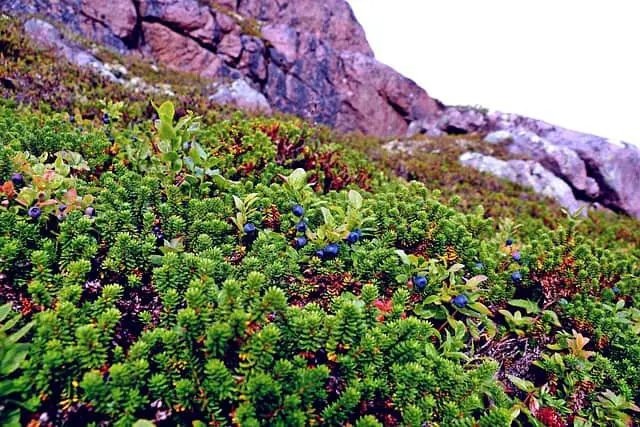
1. Lowbush Blueberries (Vaccinium angustifolium)
Wild blueberries are a popular type of wild berry in Delaware. They are small and sweet and can be found in many parts of the state. Wild blueberries are often used in baking and cooking and are a favorite of wildlife, such as bears and birds.
These berries are very similar to the highbush variety when the berries are at their absolute best. Lowbush varieties tend to be more consistently sweet. They’re smaller than the highbush blueberries. Lowbush blueberries tend to be about the size of a pea. The lowbush plants are also smaller, growing closer to the ground. In fact, you could be standing in a field full of wild lowbush blueberries and not notice at first because the plant leaves are low to the ground and covering the berries themselves.
You can find great wild blueberry bushes growing in large fields or along roadsides. They are often found in gravelly soils. They love sunny areas. Be aware that if the wild blueberries are growing along a roadside, they may be exposed to a lot of pollution from cars or get sprayed with herbicides to keep them away from the road, in which case they wouldn’t be safe to eat. It’s much better to seek these edible berries in large open fields.

2. Black Raspberries (Rubus occidentalis)
Black raspberries are absolutely delicious. Their scientific name is Rubus occidentalis, but they’re also often referred to as thimbleberry. In the early spring, black raspberry plants will have white flowers, much like the wild blueberry. Then, in the late spring or early summer, these berries will emerge first as a red color, eventually ripening to black. They will only be ripe for two to three weeks, so when you find them, you need to pick them up quickly.
The black raspberries growing in the open sun will ripen sooner than the ones hidden in the shade. If you are someone who is foraging in areas frequently and marking where you find wild black raspberry plants, it would be a good idea to note where the sunny and shaded plants are. This way, you will know which ones to forage first.
These delectable berries grow on new canes of woody shrubs and can be found along forest edges, roadsides, or abandoned fields.
Keep in mind that the ones growing along roadsides may not be safe to eat. Raspberry and blackberry plants are often seen as a nuisance, so people may spray these plants with herbicides. When they grow along roadsides, they may also be exposed to an excessive amount of exhaust. You only want to eat wild raspberries that you’re sure are healthy and safe. Look for the ones in abandoned fields and at the edges of forests in safe areas where herbicides aren’t being used.
Black raspberries have a unique combination of sweetness and tartness, making them perfect for jams, pies, or enjoying fresh berries from the vine. They are a particularly great berry for turning into ice cream if you have the patience to freeze them and make your own ice cream. For many of us, these delicious berries just aren’t going to make it that far.
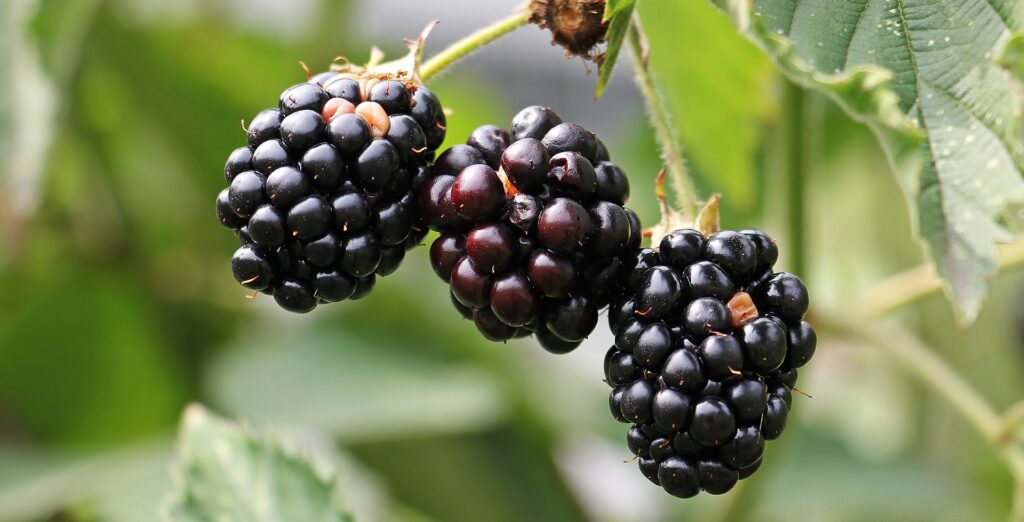
3. Blackberries
Wild blackberries are very much like the ones you find in grocery stores or farmers markets, so you’re fairly likely to be familiar with them. Unfortunately, many people consider blackberry plants to be weeds. For this reason, you’ll need to employ an extra sense of caution and question where the blackberry plant is growing before you decide the wild blackberries are safely edible.
Are these blackberries near a well-maintained park, garden, or someone’s yard, where they might have sprayed the plant with herbicide to stop its growth? Then you don’t want to eat the blackberries because they might be contaminated with chemicals. Similarly, if the plant is growing along the side of the road in a ditch, the plant is constantly absorbing pollutants from car exhaust. Be very mindful about where the plant you’ve found is growing, think about chemicals, and use your best judgment when foraging for wild blackberries.
They are sweet yet, tart fruit, rich in antioxidants, and easy to pick by the bucketful. They’re great for snacking, mixing into smoothies, or as an ingredient in baked goods. Many people freeze their blackberries to keep them around all year.
In the early spring, you’ll spot white flowers. You’ll start seeing bright glossy edible berries appear in June and July.
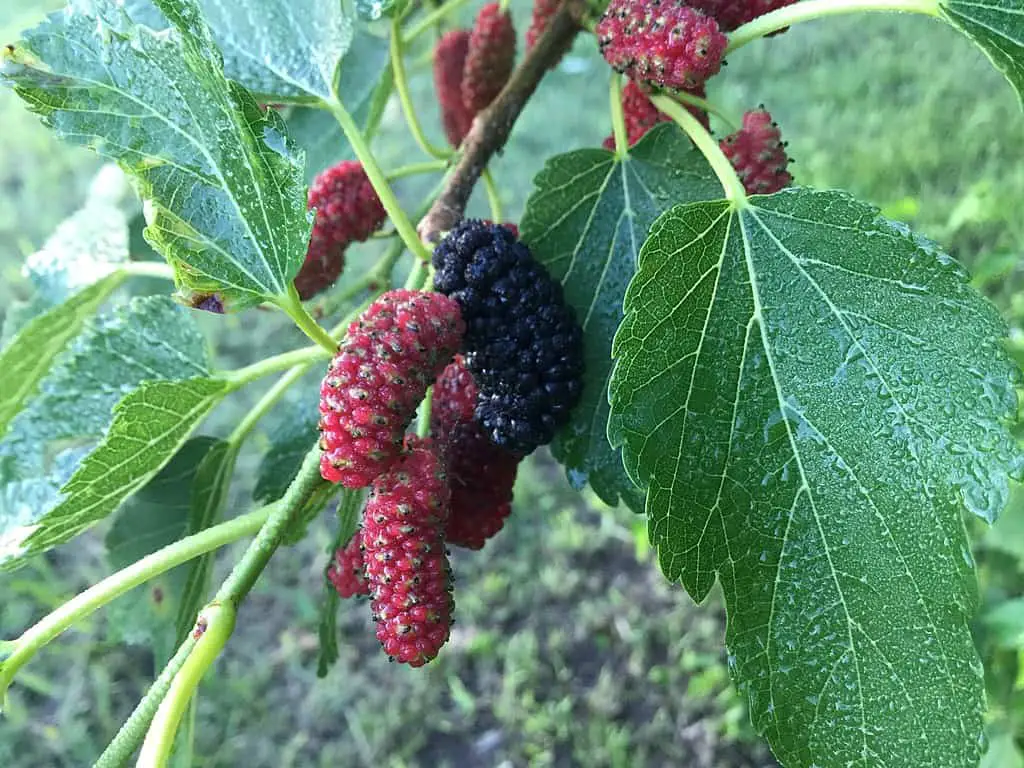
4. Red Mulberry (Morus rubra)
Red Mulberries (Morus rubra.) is a beloved wild fruit found in much of North America, including Delaware. We call them berries, but that’s a little misleading. They’re actually drupes, like cherries, plums, peaches, and apricots. This is a technicality, of course. The really important part is that drupes are edible and delicious, and better yet, red mulberry is plentiful throughout the state. These berries resemble elongated blackberries or raspberries and can range in color from red to deep purple to almost black when ripe.
The Mulberry tree is typically found in parks, along riverbanks, and in residential areas. Look for clusters of ripe mulberries hanging from the branches, and be prepared for your fingers to be stained with their sweet, juicy goodness. The best time to harvest mulberries is during late spring to early summer, usually around May and June in Delaware.
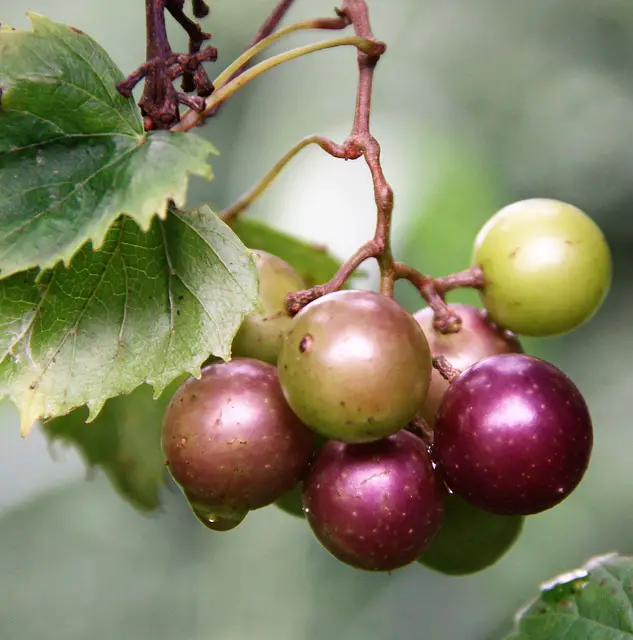
5. Muscadine Grapes (vitis rotundifolia)
Muscadine grapes are delicious and unique. These grapes thrive in their native warm and humid climate along the east coast from Florida to New Jersey. They are commonly found growing along fences, trees, and in open spaces.
You’ll recognize muscadine with its heart-shaped leaves. The young muscadine leaves can be cooked until soft in hot water and eaten, or they can be used to wrap other foods. They flower in early spring, forming clusters of small greenish-yellow flowers. The berries are bigger than the grapes you’re used to seeing at the grocery store. They have seeds and thick skins, which some people may be turned off by. But the skins are full of dietary fiber and antioxidants that can help protect against cholesterol and heart disease. They come in different colors, from bronze to purple, while wild grapes may stay green through maturity.
They’ll often fall right off the vine when they’re ready to be eaten. You’ll find them ready as early as mid-June and as late as October.
Raw berries of the Muscadine grape are great for eating fresh off the vine, but if you don’t care for the seeds and the thick skins, they are also great for making juice, while the thick skins of pressed muscadine grapes are used in animal feed and fertilizers.
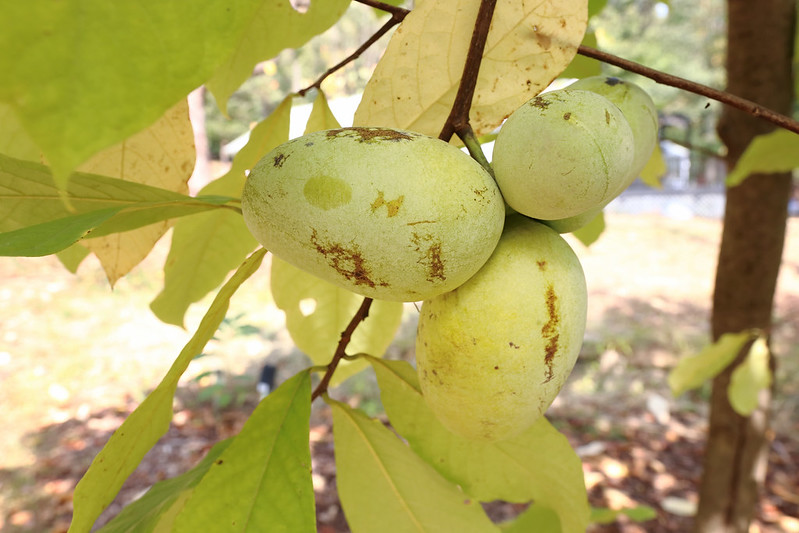
6. Pawpaw (Asimina triloba)
The American Pawpaw has the enticing name of “the banana tree of North America”. It is the only true tropical fruit native to the continental United States and is also the biggest indigenous edible fruit in Eastern North America.
The pawpaw fruit is an oblong yellowish-green berry that is 2-6 inches long, 1-3 inches wide, and weighs around 0.7 -18 oz. They have a good number of flat brown seeds embedded in the soft pulp. These edible fruits begin developing after the plant’s flower; in the early stages, they are green, maturing by September or October when the skin of the fruit changes to yellowish green or brown. The ripened fruit is fully ripe after it falls naturally from the tree.
Its unusual fruit combines a banana-like flavor with a custard-like texture. It is rich in nutrients like vitamin C, magnesium, iron, phosphorus, and potassium. In addition to the delectable fruit, pawpaw trees produce beautiful blossoms and imposing woody structures that are a favorite in home gardens.
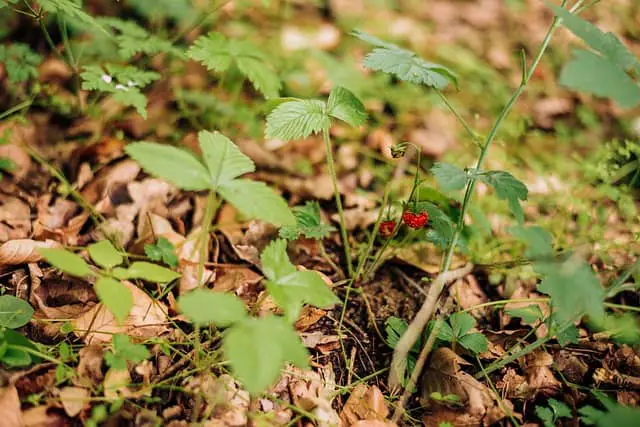
7. Wild Strawberries (Fragraria vesca)
Wild strawberry (Fragaria vesca) plants may be found on rocky or acidic soils throughout the state and are a favorite of children. They are not to be confused with the invasive false strawberry that crawls around your garden and vegetable beds. The true wild strawberry is very rare in Delaware and grows as a low shrub with showy white flower clusters.
These bright red berries are small, about the size of a thumbnail, and are packed with intense flavor. Wild strawberries can be found in open woodlands, prairies, and along forest edges. The best time to harvest these tiny treasures is in early summer, typically in June. Keep your eyes low to the ground and carefully pluck the wild strawberries.
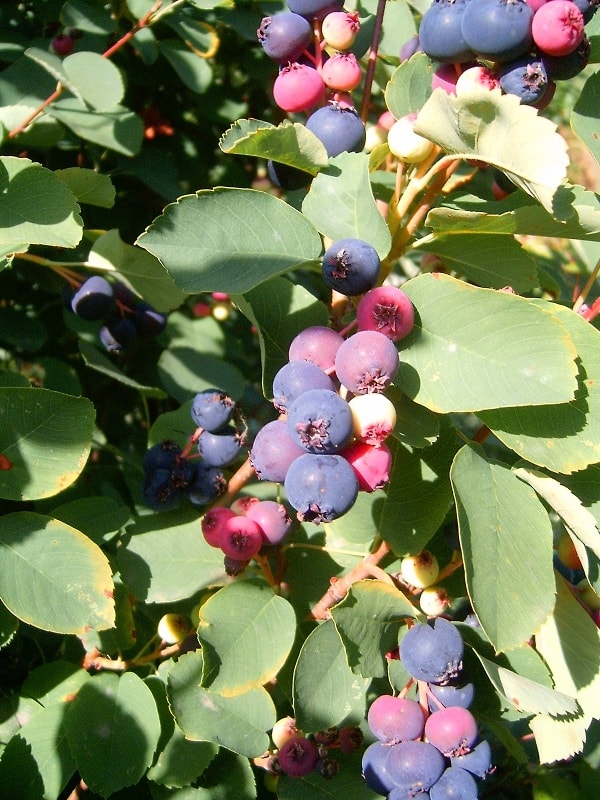
8. Serviceberry (Amelanchier arborea)
Also known as juneberries, serviceberries produce berries that resemble blueberries but with a slightly different taste. Their white flowers appear in early spring on a deciduous shrub or small tree. These berries are often used in pies and jams, offering a unique flavor profile.
When you first see serviceberries, the unripe fruit will be a pink color, but don’t be fooled. You aren’t going to enjoy eating serviceberries until the ripe berries turn dark blue or purple in July or August. Occasionally you’ll see serviceberries in June, but if you do, make sure their color has fully developed before you pick them.

9. Elderberry (Sambucus nigra)
Elderberries are only edible when they are cooked. Do not eat raw elderberries. This can be confusing when we know the berries are edible since you’ll see elderberry syrup and jam as a popular option at farmer’s markets in Delaware. They make great fruit for pies and wines as well. In these recipes, the elderberries are naturally cooked, the seeds are strained out, and the fruit is safe to eat.
Elderberries are a powerhouse of nutrients, rich in antioxidants such as vitamins C and A. You’ll find them growing in areas with dense vegetation, so look for them off the main path when you’re on a hiking trail. They like moist soil, so a good water source will be nearby.
Elderberries grow in clusters. They are small, black or blue-black, and have large, flat-topped white flowers in the early summer. You can start looking to harvest elderberries in mid-August through September.
Cautionary Note: Poisonous Berries and Lookalikes
While nature’s bounty offers an array of edible berries, it’s essential to exercise caution. Some plants, like poison ivy, produce white berries that are highly toxic and should be avoided at all costs. The best thing that you can do to avoid poisonous berries is to avoid yellow, white, or green berries, as they are more likely to be poisonous
Ensure you properly identify the plants before consuming any berries.
The most commonly found poisonous berries in Delaware include:
- American Bittersweet– Eating these yellow berries can cause upset stomach and diarrhea.
- Cotoneaster– This evergreen shrub’s bright orange berries, if eaten in large quantities, may cause respiratory problems, weakness, and seizures.
- Holly- Eating more than three red berries on this evergreen shrub can cause severe nausea, diarrhea, and vomiting along with drowsiness.
- Pokeweed– Eating over 10 of these grapelike berries may cause headaches, abdominal pain, and severe diarrhea.
- Yew– This “Christmas tree” like evergreen shrub has small red berries that, if more than 3 are eaten, can cause vomiting, abdominal pain, difficulty breathing, dizziness, and heart rate changes. See
Recent Posts
The only venomous snakes in Washington State are Northern Pacific Rattlesnakes. The Northern Pacific Rattlesnake (Crotalus oreganus oreganus) is a sub-species of the Western Rattlesnake. Anyone...
Skunks are not classified as true hibernators. But they go into a state of torpor when the weather gets cold. Skunks are light sleep hibernators, along with opossums, bears, and raccoons. ...
